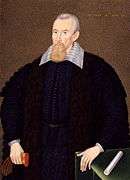Edward Bruce, 1st Lord Kinloss
Edward Bruce, 1st Lord Kinloss PC (1548 – 14 January 1611) was a Scottish lawyer and judge.[1]


_(14781747542).jpg)

He was the second son of Edward Bruce of Blairhall and Alison Reid.
In 1594 James VI sent him as ambassador to London and gave him £1,000 Scots for his expenses.[2] With James Colville, he was sent to invite Queen Elizabeth to send a representative to the baptism of Prince Henry, discuss the matter of the Earl of Bothwell, Catholics in Scotland, and ask for the yearly sum of money that Elizabeth gave to James VI. They were to ensure the money was paid to Thomas Foulis.[3] He was sent London for money from Elizabeth again in April 1598 and received £3,000.[4] He interceded in a legal case for his brother, George Bruce of Carnock, whose ship had been forced to take on a group of African and Portuguese captives.[5] He also successfully negotiated the release of Robert Ker of Cessford who was held at York by the Archbishop. On his return to Edinburgh, Bruce met with James VI in his cabinet at Holyrood Palace for four hours.[6]
He served as a Lord of Session from 1597 to 1603 and was created Lord Kinloss in 1602, with remainder to his heirs and assigns whatsoever. He played an important role in James VI's succession to the throne of England, being involved in the King's secret correspondence, and accompanied the King to England on his accession in 1603. The same year, Edward became an English subject, was admitted to the Privy Council,and appointed Master of the Rolls for life. He also received Whorlton Castle and its manor in 1603, which would remained in the Bruce family until the late 19th century.[1]
In 1604, he was made Lord Bruce of Kinloss, with remainder to his heirs male. Lord Bruce married Magdalene Clerk, daughter of Alexander Clerk. He died in London in January 1611 and was succeeded in his titles by his eldest son, also named, Edward Bruce.[1]
The children of Edward Bruce and Magdalene Clerk were:
- Edward Bruce, 2nd Lord Kinloss (1594–1613), who was killed in duel with Edward Sackville at Bergen-op-Zoom and buried there, except his heart which was buried at Culross Abbey in a heart-shaped silver case clamped with iron between two stones. The heart burial was discoved in 1808 and reburied.[7]
- Christian Bruce (died 1675), who married William Cavendish, 2nd Earl of Devonshire.
- Thomas Bruce, 1st Earl of Elgin (1599–1663)
- Robert Bruce, Baron of Skelton[8]
- Janet Bruce (who may have been born illegitimately to another mother),[1] who married Thomas Dalyell of the Binns, and was the mother of General Tam Dalyell of the Binns.
After his death, his widow married secondly Sir James Fullerton, MP and courtier, in 1616.[1] William Gouge dedicated his book A Guide to Goe to God to her and Sir James.[9]
References
- Balfour Paul, James (1904). The Scots Peerage. Edinburgh : D. Douglas. pp. 474-476. Retrieved 14 October 2018.
- Miles Kerr-Peterson & Michael Pearce, 'James VI's English Subsidy and Danish Dowry Accounts, 1588-1596', Scottish History Society Miscellany XVI (Woodbridge, 2020), p. 79
- Annie I. Cameron, Calendar State Papers Scotland: 1593-1595, vol. 11 (Edinburgh, 1936), pp. 312-4.
- Julian Goodare, 'James VI's English Subsidy', Julian Goodare & Michael Lynch, Reign of James VI (East Linton, 2000), p. 115.
- John Duncan Mackie, Calendar State Papers Scotland: 1597-1603, vol. 13 (Edinburgh, 1969), pp. 186-7, 194-5, 297, 309, 343, 345-7.
- John Duncan Mackie, Calendar State Papers Scotland: 1597-1603, vol. 13 (Edinburgh, 1969), pp. 200-4, 206.
- Lord Stowell, 'Account of the Discovery of the Heart of Lord Edward Bruce at Culross in Perthshire', Archaeologia, vol. 20 (London, 1824), pp. 515-8.
- Weeks, Lyman Horace (1907). Book of Bruce; ancestors and descendants of King Robert of Scotland. New York: The Americana Society.
- Smuts, R. Malcolm (2016). The Oxford Handbook of the Age of Shakespeare. Oxford University Press. p. 773. ISBN 9780191074172. Retrieved 14 October 2018.
| Legal offices | ||
|---|---|---|
| Preceded by Sir Thomas Egerton |
Master of the Rolls 1603–1611 |
Succeeded by Sir Edward Phelips |
| Peerage of Scotland | ||
| New creation | Lord Kinloss | Succeeded by Edward Bruce |
| New creation | Lord Bruce of Kinloss | Succeeded by Edward Bruce |
.svg.png)